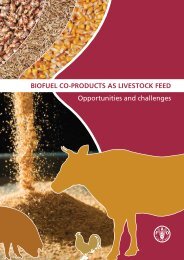Distillers Grains Feeding Recommendations. - Distillers Grains By ...
Distillers Grains Feeding Recommendations. - Distillers Grains By ...
Distillers Grains Feeding Recommendations. - Distillers Grains By ...
You also want an ePaper? Increase the reach of your titles
YUMPU automatically turns print PDFs into web optimized ePapers that Google loves.
Distiller Grain Trial Rincker and Berger (2003)OPTIMIZING THE USE OF DISTILLER GRAINFOR DAIRY-BEEF PRODUCTIONC.B. Rincker and L.L. BergerUniversity of IllinoisSUMMARYOptimizing the use of distiller grain (DG) is becoming increasingly important as ethanol productionincreases. Dairy-beef production is a system that has the potential to use large amounts of DG. Threehundredand twenty Holstein steers (420.7 + 71.5 lbs initial wt.) were fed finishing diets at theUniversity of Illinois Beef Research Unit. Forty pens were each randomly assigned to ten treatmentswith eight calves per pen. Ten dietary treatments of various DG levels were randomly assigned to 4different pens. The calves were fed ad libitum and the cattle were weighed in 28-day intervals. After112 days, both treatments 7 and 8 along with 9 and 10 were switched to represent the change from20% to 37.5% and from 37.5% to 20% for both wet distiller grain (WDG) and dry distiller grain(DDG) (DM basis). Implants were administered twice during the course of the trial. Fecal sampleswere collected on a per pen basis, sub sampled, and then analyzed for nitrogen (N), phosphorus (P),and sulfur (S). Cattle were then weighed at 270 d and sent to Packerland (Green Bay, WI) to beharvested. Effects of dietary treatment were analyzed using the GLM procedure of SAS. Orthogonalcontrasts were used for the control versus DG diets, DDG versus WDG, and diet change from 20 to37.5% DG versus 37.5 to 20% DG (represented in treatments 7 through 10). Linear and quadraticcontrasts were also used for the level of DDG and WDG.Performance values for average daily gain (ADG), dry matter intake (DMI), and feed efficiencyexpressed in feed:gain (F:G) were evaluated for the growing period (112 d) and for the entire trial (270d). Steers fed all treatments performed well and the use of DG showed the potential to improveprofitability. Steers had a significant linear decrease in ADG with an increasing level of WDG diets(P=.0202) and steers which shifted from high DG to (37.5%) low DG (20%) had significantly lowerADG than steers switched from low DG (20%) to high DG (37.5%) (P=.0035). There was asignificant quadratic effect on DMI with increasing WDG (P
















